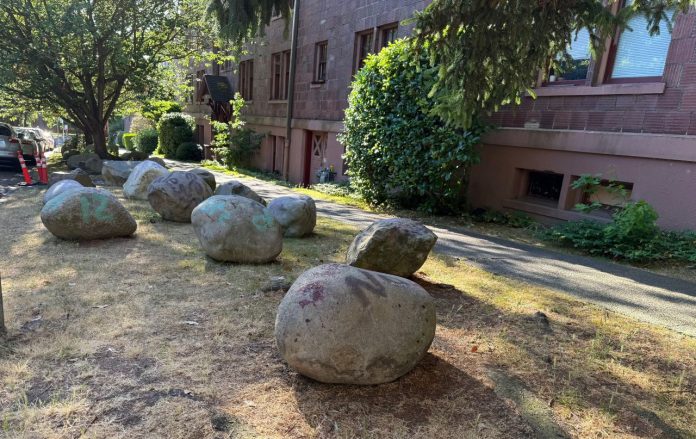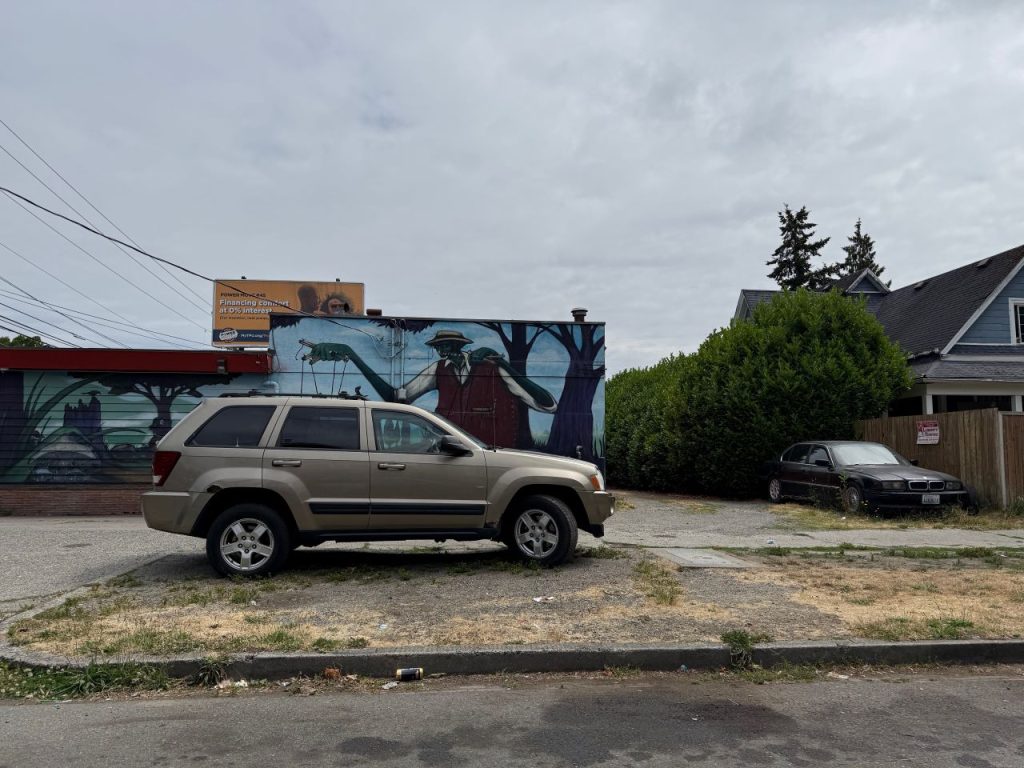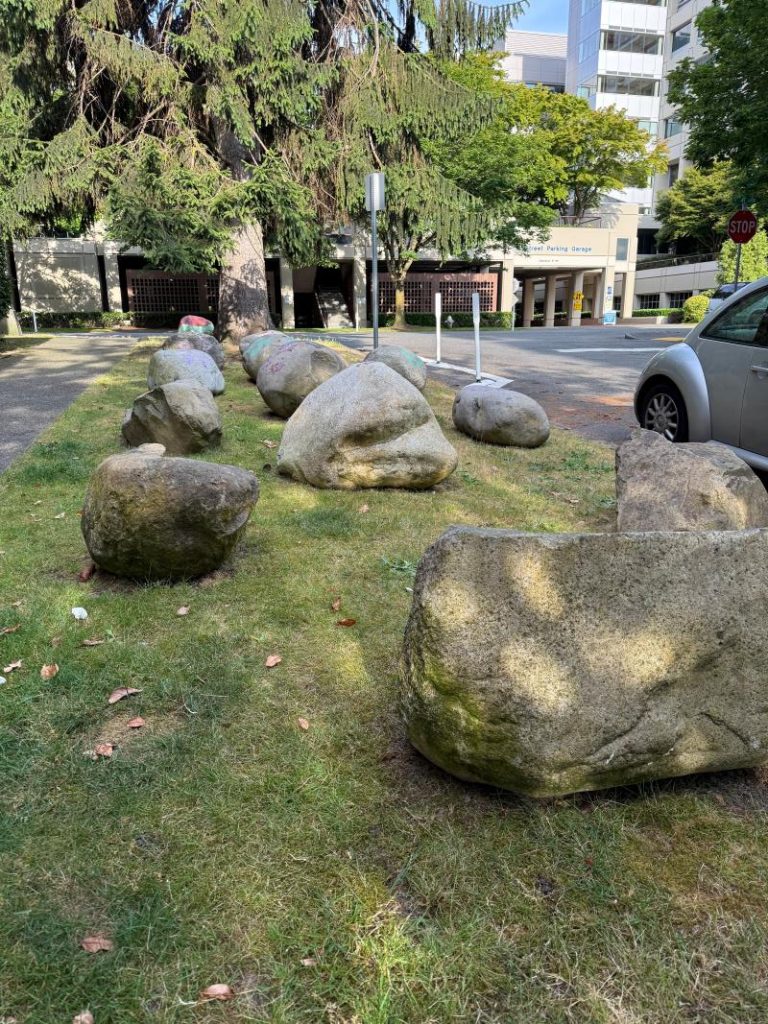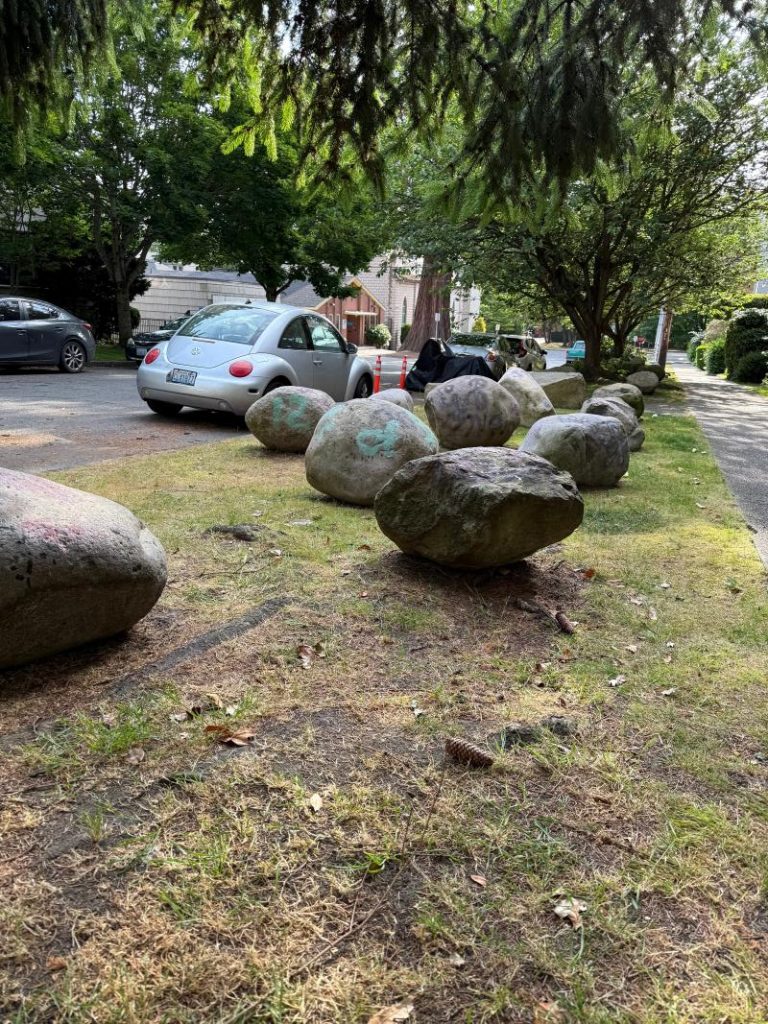
How the city uses planting strips along streets tells a tale of haves and have-nots, and of our differing standards.
In Tacoma, we apply different standards to dealing with private property stored in the right-of-way: if you’re homeless, you and what is yours are targeted for removal. If you’re a motorist, we say “stay.”
As of September 2024, the City has installed more than 1,000 rocks and boulders — at a cost of $163,000 — in planting strips across the city to deter homeless encampments.
Planting strips are fair game, however, if you happen to arrive at your location and you cannot find a parking space curbside. Hop the curb and park on the planting strip; chances are no one will complain and parking enforcement won’t ticket you (even though driving or parking in this part of the right-of-way is against Washington State law).
Throughout the city, you can find people parking (storing) their private property in the right-of-way, and neighbors and law enforcement largely willing to look the other way.

This contradiction says a lot about Tacoma and Tacomans.
This intolerance towards the property of unhoused people in the right-of-way is evidenced in the high levels of complaints the City receives about “the homeless,” in laws passed that prevent setting up a camp near certain facilities that serve those experiencing housing insecurity or lack of housing, and in the hostile architecture deployed to prevent unhoused people from placing their property in the right-of-way.
Look around and you are likely to find evidence of the tolerant attitudes we have towards similar and, arguably, equally disruptive and destructive use of that right-of-way if those storing their property on planting strips are, we presume, property owners (or renters, at least), just like us. Find vehicles, trailers, boats, campers, and RVs parked on the planting strip throughout the city.
But homeless encampments bring crime and trash, we are told, and therefore detract from property values. Others say that the unhoused make them feel unsafe or uneasy. Tacoma, like many cities, is willing to remove unhoused people and their property when residents call to complain.
A vehicle on the planting strip does not evoke similar feelings, responses, or enforcement. Some might defend this instance of storing private property in the right-of-way in opposite terms, arguing that parking on the planting strip does not pose a threat to the public. Except that it does: cars parked on the planting strip do not contribute to traffic calming and they obfuscate the sight lines of other drivers. This combination of factors—higher speeds and blind spots—put children and others at risk on our already dangerous roads.
Sometimes it is oversized vanity trucks and RVs that are stored on planting strips because these exceed the available space allotted to vehicle storage at the curb. To park on the street would disadvantage other motorists, so let’s park on the planting strip and inconvenience non-motorists instead. You see this when an oversized vehicle’s front- or tail-end extends onto the sidewalk, forcing pedestrians onto the roadway.
For many, this is just “a Tacoma thing” (not that you don’t observe this behavior in other Washington cities — but you especially see it in the City of Destiny). For others it is another clear example of how a society and its communities use property and its ownership as a meaningful differentiator.
Private property comes with its privileges in our society and in Tacoma, too. It gives you a greater claim to public assets and to how presence and access to these is enforced. A lack of property — or giving the appearance that you don’t own anything — strips you of access and dignity.
Certainly, the City will say that it does not have enough resources to curb the illegal behavior that is parking on planting strips (and there are so many things that could be done on a planting strip that are not hostile and which promote the common good).
Yet, the City is capable and resourced enough to enforce against unhoused people using the planting strip to store their things.


Here is an opportunity to ask better questions about access, equity, and dignity in our city, as well as the uneven attitudes and standards we all apply to how we care for our common property. Because this is just as much about the willingness of our City to act on behalf of people with “real” property against those who don’t own it, as it is about our contradictory standards and what it says about us.
Tacoma is making strides in restoring and growing the urban tree canopy, an ambitious and laudable effort that has been partly articulated as a matter of equity. The right-of-way, particularly our planting strips, offers one of the most ready resources to make more progress. We can scale-up depaving and tree-planting to maximize the public good, or we can continue to cultivate rock gardens and de-facto parking lots.
The City has deployed rocks and boulders at more than 20 sites across Tacoma. As large as this figure reads, it represents a fraction of the vehicles and other private property you will find stored in planting strips across the city on any given day.
In Tacoma, an unhoused person stands to be left alone for longer if they put their car on the planting strip before turning in for the night than if they close their eyes in a tent. We should ask ourselves what the implications are when we apply different standards to whose property is accommodated in the planting strip — and why.

Rubén Casas
Rubén joined The Urbanist's board in 2022. He is a scholar and teacher of rhetoric and writing at the University of Washington Tacoma. He is also the faculty lead of the Urban Environmental Justice Initiative at Urban@UW. In his work and advocacy, Rubén examines how cities and the institutions that comprise them imagine, plan, and build in ways that promote and/or discourage community and a sense of place.
